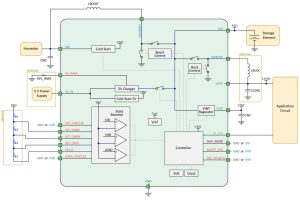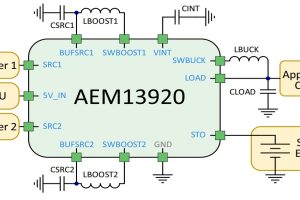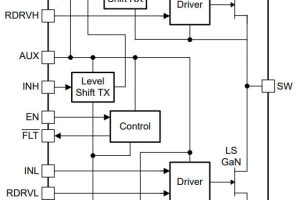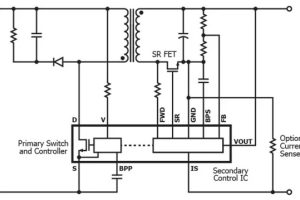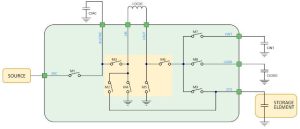
There are three parts:
- AEM00940: harvesting and storage manager with LDO
Two regulated outputs
Supercapacitor or battery storage
Optional primary battery back-up source
Boost harvester interface
Harvest voltage settable across 50mV to 4.5V
380mV cold start (3µW typical) - AEM10300 harvesting and storage manager
Supercapacitor or battery storage
Second storage channel
Buck-boost harvester interface
Harvester automatically tracks peak power from 100mV to 4.5V
275 mV cold start (3µW typical) - AEM10330 harvesting and storage manager with LDO
As AEM10300, plus a 1.2 – 3.3V regulated output
All of the ICs are designed to be complete harvester interfaces, able to work with photovoltaic cells, that can temporarily store energy in a supercapacitor or rechargeable bettery and need only
a handful of passive components to operate
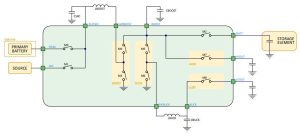 AEM00940 has been designed to work with harvested energy sources that operate best at a particular fixed voltage. Once it has started up, a feedback loop forces the harvester to work at that voltage, which is programmable across 50mV to 4.5V using two resistors.
AEM00940 has been designed to work with harvested energy sources that operate best at a particular fixed voltage. Once it has started up, a feedback loop forces the harvester to work at that voltage, which is programmable across 50mV to 4.5V using two resistors.
The front-end is able to accept up to 110mA from the harvester.
The input is boost-convertered up into the energy store, which can be a supercapacitor or a rechargeable battery. To allow two supercaps to be used in series, a center-pont balancing output is provided.
If harvested energy is available continuously, the store can be replaced with a normal capacitor of at least 150μF.
From the energy store, there are two output regulators.
The first is an linear LDO (300mV drop-out) that can be set to deliver between 1.8 and 4.1V at up to 80mA and is nominally there to power a radio tranceiver. This output can be turned on and off through a pin.
The second output, nominally for a microcontroller, is powered from the reservoir through a buck dc-dc converter and LDO, and can be set to deliver between 1.2 and 1.8V at up to 20mA. This output can also be gated using an external pin.
Optionally, a non-rechargeable (‘primary’) call can be added to the circuit that will only be used at times when the main rechargeable store is depleted.
Measurement circuits and configuration pins allow various parameters to be set including the over-charge and over-discharge voltages of the energy storage element.
 AEM10300 and AEM10330 (pictured right) are similar, the only difference being that the …330 version includes an LDO to produce a regulated output from the storage element between 1.2 and 3.3V at 30mA (in low power mode) or 60mA (high power mode).
AEM10300 and AEM10330 (pictured right) are similar, the only difference being that the …330 version includes an LDO to produce a regulated output from the storage element between 1.2 and 3.3V at 30mA (in low power mode) or 60mA (high power mode).
Compared with the AEM00940, the harvester is more sophisticated in operation, having a boost-buck converter that can automatically switch mode to handle inputs between 100mV and 4.5V, plus they include a choice of open-loop control methods to extract more power from the harvester (a photovoltaic cell, for example) than the fixed input voltage approach. Both methods need prior knowledge of the harvesters characteristics rather than using closed-loop power tracking.
Method one periodically turns off the input converter, measures the harvester’s open-circuit voltage, and then re-enables the converter set to regulate the harvester voltage to a fixed percentage of the open-circuit voltage – the percentage used is preset using a number of device pins.
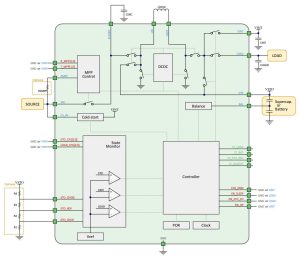
More AEM30330 detail
The other control method continually measures converter (and therefore havester) current and voltage, varying the converter operating point to make the load presented to the harvester look like a constant resistance. This apparent resistance is set by a single external resistor connected to a device pin.
Power from the input dc-dc converter can be directed to the load or the storage capacitor that poweres the IC’s internal circuitry, or the main energy storage supercap/battery. Which gets filled first is pin programmable. Either of these can be directed to power the load in the case of the …330 version.
Lastly, if the loaded harvester output voltage rises above 5V, an internal switch automatically connectes its output directly to the main energy store.
As with the AEM00940, the energy store’s votage is monitored and managed, and there is a centre-point regulator for balancing dual series-connected supercaps.
E-Peas’ complete list of storage types for all these of the ICs above are: single and dual cell supercapacitors, Li-Ion, LiFePO4, Li-Po, NiCd, thin film batteries and solid-state batteries.
Packaging and web pages:
AEM00330 5 x 5mm 40pin QFN
AEM00300 4 x 4mm 28pin QFN
AEM00940 5 x 5mm 28pin QFN
Bare die are also available, and evaluation kits are in the pipeline.
 Electronics Weekly Electronics Design & Components Tech News
Electronics Weekly Electronics Design & Components Tech News
